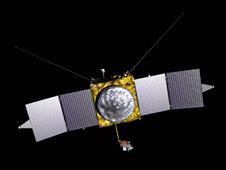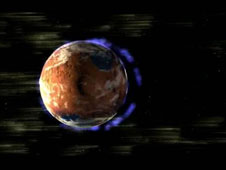Maven will be launched in 2013, two years later than originally planned due to a nine-month delay in the decision-making process

NASA has chosen a robotic mission to Mars that will provide information about the atmosphere, the climatic history and the potential ability to sustain humans. The mission, known as Mars Atmosphere and Volatile EvolutioN (or MAVEN for short), which has a budgeted cost of 485 million dollars, is planned for launch at the end of 2013.
The selection was from among 20 proposals submitted in response to NASA's announcement of a request for proposals in August 2006.
"This mission will provide the first-ever precise measurements designed to ask scientific questions about the evolution of the planet," said Doug McKeestion, director of the Mars Exploration Program at NASA Headquarters in Washington.
Mars once had a denser atmosphere that supported the presence of flowing water on the surface. As part of the dramatic climate changes, most of the atmosphere was lost. Maven will attempt to make precise scientific measurements of the current rate of atmospheric loss and offer clues to the planet's history.
"The loss of the Martian atmosphere has been an ongoing puzzle," McKistion said. "Maven will try to help us solve it." The mission's principal investigator will be Bors Jakowski of the Atmospheric and Space Physics Laboratory at the University of Colorado at Boulder. The university won a grant of six million dollars for the planning and development of the technology during the coming year. NASA's Goddard Center in Maryland will manage the project and Lockheed-Martin will build the spacecraft based on the design of the MRO and Mars Odyssey 2001 spacecraft. The team will begin design and manufacture of the mission in the fall of 2009.
MRO Launched in 2005, it is a multi-purpose spacecraft carrying a powerful telescopic camera - the most powerful to fly to another planet. The camera can show surface contours the size of a table from low orbit. The mission examines potential landing sites for future missions and to serve as a communication relay for other spacecraft on Mars. March Odyssey 2001 Launched in April of that year, it was designed to determine the composition of the surface and search for water and ice buried at a shallow depth. The spacecraft also studies the radiation environment of the planet.

After reaching Mars in the fall of 2014, Maven will use its propulsion systems to enter an elliptical orbit that will extend from an altitude of 150 km to an altitude of about 6,500 km. The eight instruments will measure its atmosphere for an entire Earth year, which is about half a Martian year. Maven will also dive to an altitude of 130 km above the planet to sample the upper atmosphere. During and immediately after the main mission, the spacecraft will also be used to provide a communication relay for the robotic missions on the surface of Mars.
Maven belongs to the series of Mars scanners (SCOUT) missions in which small, cheap, dedicated spacecrafts are launched for the study of the red planet. The Phoenix lander mission was the first chosen. Phoenix landed in the Arctic region on May 25, 2008. Its main mission was supposed to end on August 25. The mission was extended until September 30.
And in the meantime, the news agencies report that the choice of the University of Colorado was postponed by nine months compared to the original plan, a postponement that cost NASA 10 million dollars, the launch was postponed by two years and the operating duration of the spacecraft was shortened to one year. The reason for the postponement - fear of a conflict of interests among the members of the committee.

4 תגובות
To Ami Bachar
1. In my opinion, the research, the information and the conclusions derived from them, are more interesting and fascinating to the eye than "putting your hands on soil that came from Mars". After all (as far as I know), the soil on Mars, like the soil on Earth, originates from supernova explosions. When you hold it in your hand, it will look the same (more or less).
2. To the best of my knowledge, Amral has the text "Adam that has arrived.." and not "Adam that has arrived.."
A terrible waste.
These funds could have been invested in the resettlement of the plasticine throughout the Arabian and African deserts and this would have solved a significant part of humanity's problems.
Ami
Well, your request was also entered in the register....the bioni...
It's so ticklish to ask why they couldn't have put an atmospheric sampling lab on the spacecraft that landed in May of this year, in addition to the ground lab. I definitely understand the issue of space, money and efficiency, but it's so ticklish and everyone is so impatient. Life is so short and we are "dying" to know what is happening there. In a few years there will be cm by cm chips that will do all the chemistry, biology and physics and they will cost a fortune and we will be very sorry that we didn't have this tiny technology back then, when we sent some probe to Mars. My big dream - to put my hands on land that came from Mars. I would be willing to work on it for free too… 🙂
Greetings friends,
Ami Bachar